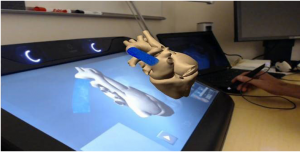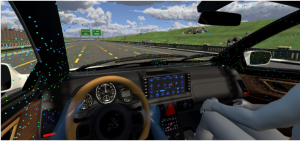
Watching a high-quality simulation is incredible, particularly if one has never seen the technology before. Now imagine not only watching a simulation, but physically interacting with it. This is now possible through the combination of simulation and a technology called Immersive Virtuality, which includes virtual, augmented and mixed reality.
Immersive Virtuality brings together real and virtual worlds through the following technologies:
- Virtual reality, which surrounds users with a digital environment
- Augmented reality, which superimposes digital objects on a real-world environment
- Mixed reality, which superimposes and anchors digital objects to a real-world environment and allows users to interact with them
One of the most well-known applications for Immersive Virtuality is gaming, but its uses go far beyond entertainment. Users can now observe the air flow around a jet engine, for example, or the blood flow through a heart.
The implications for the medical field alone are astonishing. Medicine has advanced beyond the days when a physician would have to try to explain a complex, three-dimensional issue using a one-dimensional image – or even a 3D plastic model. Now, with Immersive Virtuality, medical professionals can show patients a moving, three-dimensional, real-time image of the insides of their bodies, allowing them to understand their conditions more fully.
The key to Immersive Virtuality is virtual twinning, which is the process by which complex real-world objects are recreated in a 3D environment. Building a virtual twin into a virtual reality environment allows consumers to experience digital versions of products before they buy the real thing. This also enables manufacturers to test design aspects in a digital setting before creating a physical prototype, letting them know of potential issues in early design stages.

For example, an Immersive Virtuality experience of a car can provide valuable information about noise, handling, and even reflections off the car’s hood that could potentially irritate the driver. If those reflections were discovered after the car was already physically manufactured, it would be far too late to change the design, but a test that places users in the virtual environment of a car can help to identify and alter such issues easily in the stages before production.
As consumers continue to demand products personalized to their own needs, Immersive Virtuality becomes ever more important, allowing these consumers to try out and select various product features before they are produced.
Physical tests also have limitations when it comes to “seeing” the impact of various forces that work together to affect the performance of a product such as a car. Multiple teams working on often-competing targets for vehicle performance can, with Immersive Virtuality, evaluate the vehicle’s full 3D geometry as the various areas evolve simultaneously.
Immersive Virtuality also has a large role to play in the educational sphere. Medical students are already learning about topics such as blood flow and electrical activity in the human body through virtual experiences, which allow them to see objects and processes that would be impossible to see otherwise.
SIMULIA’s Living Heart Project is an example of how Immersive Virtuality can show observes the unseen: the beating heart model, which viewers can walk through and around, reveals all of the complex components of the heart as well as its behaviors. This model is being used around the world to design and test new devices and drug treatments for heart disease, which is currently the world’s leading cause of death.
Immersive Virtaulity is simulation that surrounds, allowing users to enter the world of a product, a location or even a human body. The technology will only continue to advance, merging the virtual and the real in a single experience.
To learn more about Immersive Virtuality, take a look at the whitepaper “Bringing Simulation to Life with Immersive Virtuality.” It can be accessed here.
SIMULIA offers an advanced simulation product portfolio, including Abaqus, Isight, fe-safe, Tosca, Simpoe-Mold, SIMPACK, CST Studio Suite, XFlow, PowerFLOW and more. The SIMULIA Community is the place to find the latest resources for SIMULIA software and to collaborate with other users. The key that unlocks the door of innovative thinking and knowledge building, the SIMULIA Community provides you with the tools you need to expand your knowledge, whenever and wherever.
